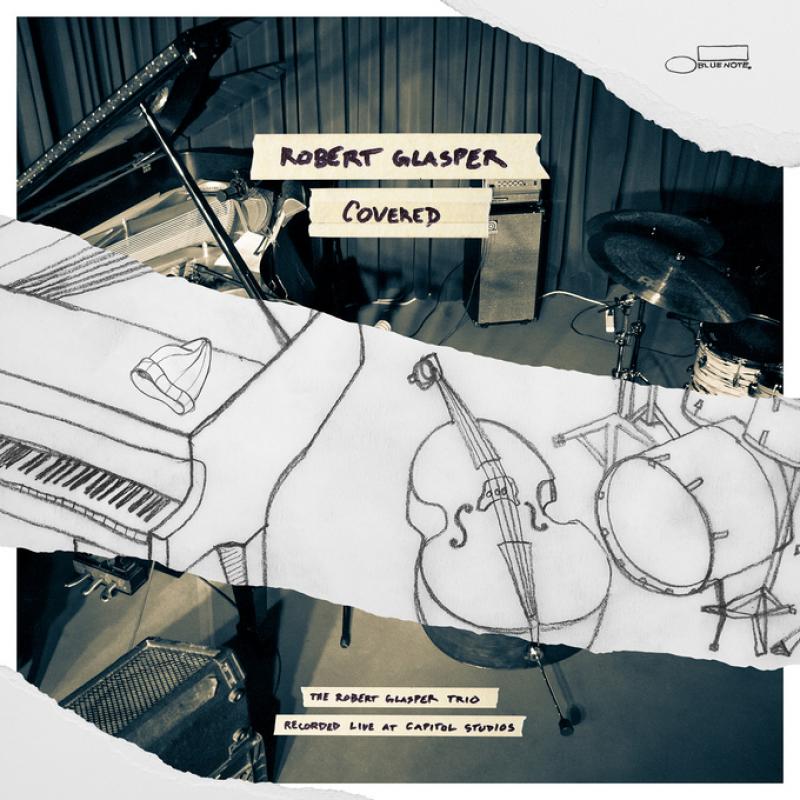CD: Robert Glasper – Covered | reviews, news & interviews
CD: Robert Glasper – Covered
CD: Robert Glasper – Covered
New material gets vintage jazz treatment as Glasper marks ten years at Blue Note

Robert Glasper has recently been making a name, and winning Grammys with his electronic fusion outfit, the Robert Glasper Experiment. After years of Casey Benjamin’s croaking vocoder on the Black Radio albums, the pealing acoustic notes of Glasper’s conventional trio are almost a surprise. Also novel by Glasper’s standards is the source material: there’s only one standard, “Stella By Starlight”. Many of the rest of are, as the title suggests, covers.
Glasper’s caustic frustration with the jazz world’s navel-gazing (“I feel like jazz needs a big-ass slap,” he wrote in DownBeat in 2012) might imply a radical approach, but in many cases Glasper plays it fairly straight. For all the novelty of the choices, Glasper’s concept of jazz technique is appealingly traditional, with firecracker solos and outbursts of vigorous melody like the rainbow after the storm. Joni Mitchell’s “Barangrill”, Radiohead’s “Reckoner” and Musiq Soulchild’s “So Beautiful” have a charming melodic lilt, their themes left to speak for themselves, with only a subtle Glasperisation. “Stella By Starlight”, by contrast, is worked over much more rigorously, in keeping with its jazz familiarity.
Belafonte’s contribution, a defiant assertion of black cultural identity, and the closing song, Lamar’s “I’m Dying of Thirst”, in which children recite the names of black victims of police shootings, are both unimpeachable statements, but the use of the very old and very young can’t help but verge on the mawkish. Yet here, as with the arrangements, there’s something refreshingly clear-eyed about Glasper’s approach. In many ways, this album recalls the time jazz was a genuinely popular music, with tunes, virtuosity, and something important to say.
rating
Share this article
The future of Arts Journalism
You can stop theartsdesk.com closing!
We urgently need financing to survive. Our fundraising drive has thus far raised £49,000 but we need to reach £100,000 or we will be forced to close. Please contribute here: https://gofund.me/c3f6033d
And if you can forward this information to anyone who might assist, we’d be grateful.

Subscribe to theartsdesk.com
Thank you for continuing to read our work on theartsdesk.com. For unlimited access to every article in its entirety, including our archive of more than 15,000 pieces, we're asking for £5 per month or £40 per year. We feel it's a very good deal, and hope you do too.
To take a subscription now simply click here.
And if you're looking for that extra gift for a friend or family member, why not treat them to a theartsdesk.com gift subscription?
more New music
 Album: Nova Twins - Parasites & Butterflies
Exciting London duo turn inward and more introspective with their third album while retaining their trademark hybrid sound
Album: Nova Twins - Parasites & Butterflies
Exciting London duo turn inward and more introspective with their third album while retaining their trademark hybrid sound
 Music Reissues Weekly: The Beatles - What's The New, Mary Jane
John Lennon’s queasy, see-sawing oddity becomes the subject of a whole album
Music Reissues Weekly: The Beatles - What's The New, Mary Jane
John Lennon’s queasy, see-sawing oddity becomes the subject of a whole album
 The Maccabees, Barrowland, Glasgow review - indie band return with both emotion and quality
The five-piece's reunion showed their music has stood the test of time.
The Maccabees, Barrowland, Glasgow review - indie band return with both emotion and quality
The five-piece's reunion showed their music has stood the test of time.
 Album: Blood Orange - Essex Honey
A triumph for the artist who doesn't clamour for attention but just keeps growing
Album: Blood Orange - Essex Honey
A triumph for the artist who doesn't clamour for attention but just keeps growing
 Houghton / We Out Here festivals review - an ultra-marathon of community vibes
Two different but overlapping flavours of subculture full of vigour
Houghton / We Out Here festivals review - an ultra-marathon of community vibes
Two different but overlapping flavours of subculture full of vigour
 Album: Wolf Alice - Clearing
Ten years from their debut, Wolf Alice once again make magic from the familiar
Album: Wolf Alice - Clearing
Ten years from their debut, Wolf Alice once again make magic from the familiar
 Album: Deftones - Private Music
Deftones give us a glimmer of hope, but that's all...
Album: Deftones - Private Music
Deftones give us a glimmer of hope, but that's all...
 Album: Eve Adams - American Dust
Taking inspiration from the Californian desert
Album: Eve Adams - American Dust
Taking inspiration from the Californian desert
 Gibby Haynes, O2 Academy 2, Birmingham review - ex-Butthole Surfer goes School of Rock
Butthole Surfers’ frontman is still flying his freak flag but in a slightly more restrained manner
Gibby Haynes, O2 Academy 2, Birmingham review - ex-Butthole Surfer goes School of Rock
Butthole Surfers’ frontman is still flying his freak flag but in a slightly more restrained manner
 Album: Adrian Sherwood - The Collapse of Everything
The dub maestro stretches out and chills
Album: Adrian Sherwood - The Collapse of Everything
The dub maestro stretches out and chills
 Music Reissues Weekly: The Residents - American Composer's Series
James Brown, George Gershwin, John Philip Sousa and Hank Williams as seen through an eyeball-headed lens
Music Reissues Weekly: The Residents - American Composer's Series
James Brown, George Gershwin, John Philip Sousa and Hank Williams as seen through an eyeball-headed lens
 Album: Dinosaur Pile-Up - I've Felt Better
Heavy rock power pop trio return after an unwanted lengthy break
Album: Dinosaur Pile-Up - I've Felt Better
Heavy rock power pop trio return after an unwanted lengthy break

Add comment